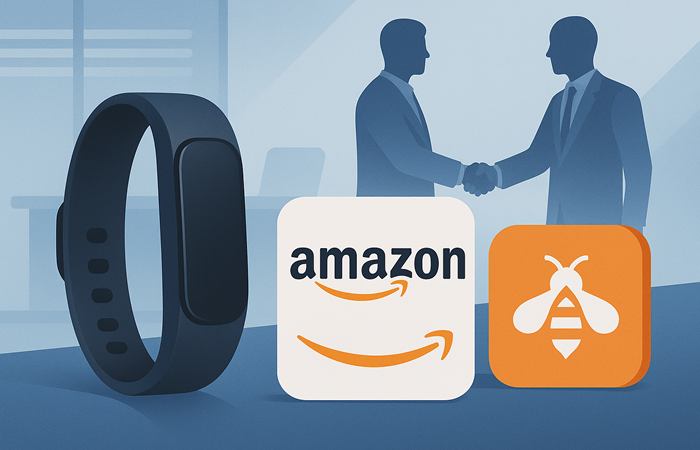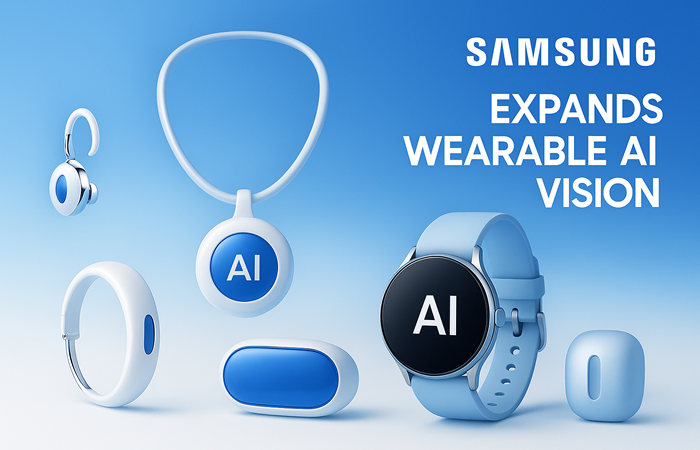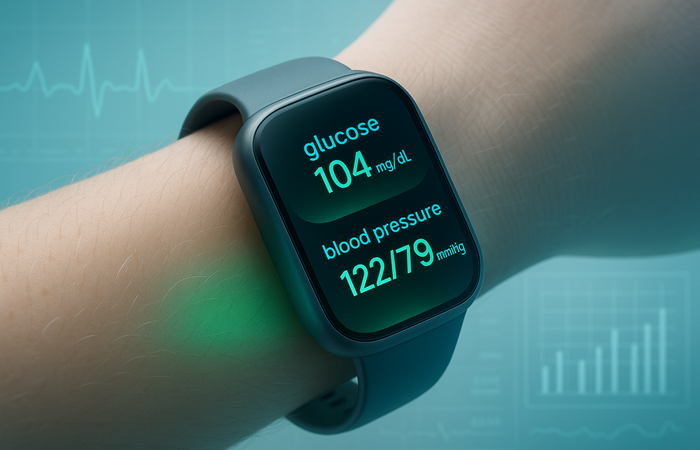July 2025 Wearable AI Wrap
July 2025 Wearable AI Wrap: Three Game-Changing Breakthroughs
July 2025 proved to be a watershed moment for wearable AI technology, delivering three groundbreaking developments that could reshape how we interact with intelligent devices on our bodies. From major corporate acquisitions to revolutionary health monitoring breakthroughs, this month demonstrated that wearable AI is rapidly moving from experimental gadgets to essential daily companions.
1. Amazon’s Strategic Acquisition of Bee AI Signals Major Tech Giant Entry
Amazon confirmed its acquisition of Bee, a San Francisco-based startup that creates a $49.99 USD wristband equipped with AI and microphones capable of listening to and analysing conversations to provide summaries, to-do lists and reminders for everyday tasks. The announcement, made by Bee CEO Maria de Lourdes Zollo on LinkedIn in late July, represents Amazon’s most significant re-entry into the wearable AI space since discontinuing its Halo fitness tracker in 2023.
What makes this acquisition particularly noteworthy is Bee’s unique approach to ambient intelligence. The device records everything it hears — unless the user manually mutes it — with the goal of listening to conversations to create reminders and to-do lists for the user. Unlike traditional voice assistants that require wake words, Bee operates continuously in the background, learning patterns and preferences to provide contextual assistance.
The device’s technical specifications underscore its practical appeal for Australian consumers. Bee features dual microphones and advanced noise filtering to ensure clear comprehension and transcriptions, with a battery that can last over 160 hours on a single charge. For busy professionals working long shifts or managing complex schedules, this represents a significant leap forward in hands-free productivity tools.
However, the acquisition raises important privacy considerations that Australian consumers should understand. In its current privacy policies, Bee says that users can delete their data at any time and that audio recordings are not saved, stored, or used for AI training. Amazon’s integration of this technology into its broader AI ecosystem could potentially influence how personal data is handled, making it crucial for users to stay informed about policy changes.
The RRP for the Bee wearable is approximately $73 AUD (converted from $49.99 USD), plus a monthly subscription fee of around $28 AUD ($19 USD). Whilst the device currently only ships to the United States, Amazon’s acquisition suggests broader international availability may follow.

2. Samsung Expands Wearable AI Vision Beyond Traditional Form Factors
July 2025 saw Samsung make bold declarations about the future of wearable AI devices, extending far beyond conventional smartwatches and fitness trackers. Samsung mobile executive Won-joon Choi revealed the company is exploring new wearable devices, potentially including earrings and necklaces, amid an industry-wide push to develop new types of AI-powered consumer electronics.
This strategic shift reflects Samsung’s recognition that AI could enable entirely new categories of wearable devices. Choi explained that AI could enable a new wave of devices that allow users to communicate and get things done more quickly without having to take out a phone. For Samsung, these innovations represent opportunities to create devices that are truly wearable rather than portable.
The company’s approach focuses on seamless integration with existing technology ecosystems. Samsung’s approach will involve devices that function as companions to your phone rather than standalone products, similar to the company’s smartwatches. This philosophy suggests that future Samsung wearable AI devices will enhance rather than replace smartphones, aligning with the complementary relationship identified in our market research.
Moreover, Samsung’s commitment extends to addressing diverse user preferences and needs. The company is actively working on glasses, but recognises that some people do not want to wear glasses because they change their look, leading them to explore other types of devices. This user-centric approach could prove particularly valuable in the Australian market, where practical functionality often takes precedence over technological novelty.
The timeline for these innovations remains fluid, but Samsung’s public commitment suggests we may see prototype demonstrations or early product announcements within the next 12-18 months. Australian consumers should anticipate these developments as part of Samsung’s broader Galaxy ecosystem expansion.

3. Revolutionary Non-Invasive Health Monitoring Achieves Clinical Breakthrough
Perhaps the most scientifically significant development of July 2025 was the successful clinical validation of non-invasive glucose and blood pressure monitoring technology. Silicon Valley startup LifePlus announced successful trials of LifeLeaf, a wrist-worn device that continuously measures glucose and blood pressure cufflessly, with multi-centre trials spanning four continents showing highly accurate readings within approximately 10.8% of traditional glucometers and minimal blood pressure error.
This breakthrough represents the realisation of what many consider the “holy grail” of wearable health technology. The AI-powered sensor platform requires no fingersticks, no arm cuff, and no calibration, yet closely matched invasive continuous glucose monitors with only approximately 8.5% difference versus Dexcom G6. For millions of Australians managing diabetes or cardiovascular conditions, this technology could eliminate the daily burden of invasive monitoring procedures.
The implications extend beyond individual convenience to broader healthcare system benefits. Experts hailed it as a breakthrough without the usual barriers of needles or cuffs that could improve patient adherence and early disease detection. In Australia’s healthcare context, where remote monitoring and preventive care are increasingly prioritised, such technology could significantly reduce healthcare costs whilst improving patient outcomes.
Additionally, July 2025 saw complementary advances in integrated diabetes management. PharmaSens (Switzerland) and SiBionics (China) unveiled “niia™ signature,” an all-in-one patch combining a continuous glucose sensor with an insulin pump, aiming to automate glucose control and reduce the daily burden for insulin users by unifying two devices into one.
These developments collectively signal that wearable AI is transitioning from wellness gadgets to clinical-grade medical devices. By integrating sophisticated sensors and AI, wearables are moving from wellness gadgets to clinical-grade medical devices for chronic disease management. Australian healthcare providers and patients should prepare for regulatory submissions and potential availability of these technologies within the next 2-3 years.

What These Developments Mean for Australian Consumers
These three breakthroughs collectively demonstrate that July 2025 marked a pivotal moment in wearable AI evolution. Amazon’s acquisition of Bee signals that major tech giants are seriously investing in ambient AI assistants, suggesting more sophisticated and accessible options will emerge. Samsung’s expansion beyond traditional form factors indicates that wearable AI will become more diverse and personalised to individual preferences and lifestyles.
Most significantly, the validated clinical applications of non-invasive monitoring technology suggest that wearable AI is maturing from experimental technology to practical healthcare solutions. For Australian consumers, this means making informed decisions about current purchases whilst staying alert to emerging technologies that could provide substantial health and productivity benefits.
The convergence of these developments suggests that by 2026-2027, Australians will have access to a much broader range of wearable AI devices that are more capable, more integrated, and more essential to daily life than anything currently available. The foundation laid in July 2025 positions wearable AI as a genuine complement to smartphones rather than a replacement, exactly as our market analysis predicted.